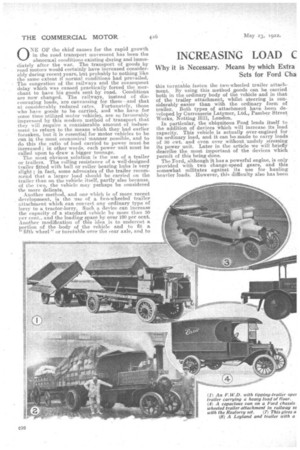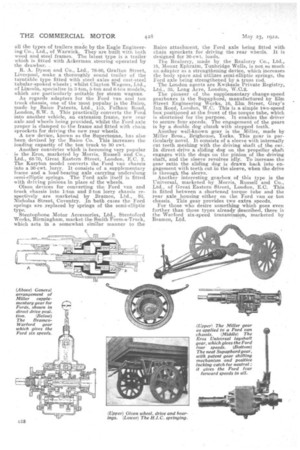INCREASING LOAD C Y PER POWER UNIT.
Page 16

Page 17

Page 18

If you've noticed an error in this article please click here to report it so we can fix it.
Why it is Necessary. Means by which Extra
Sets for Ford Cha e Transported. Types of Trailers. Conversion mentary Gearboxes.
ONE OF the chief causes for the rapid growth in the road transport movement has been the abnormal conditions existing during and immediately after the war. The transport of goods by road motors would certainly have increased considerably during recent years, but probably to nothing like the same extent if normal conditions had prevailed. The congestion of the railways and the consequent delay which was caused practically forced the merchant to have his goods sent by road. Conditions are now changed. The railways, instead of discouraging loads, are canvassing for them— and that at considerably reduced rates. Fortunately, those who have goods to be carried, and who have for some time utilized motor vehicles, are so favourably impressed by this modern method of transport that they will require a considerable amount of inducemeut to return to the means which they had earlier forsaken, but it is essential for motor vehicles to be run in the most economical manner possible, and to do this the ratio of load carried to power must be increased ; in other words, each power unit must be called upon to draw a bigger tonnage.
The most obvious solution is the use of a trailer or trailers. The rolling resistance of a well-designed trailer fitted with ball or roller bearing hubs is very slight ; in fact, some advocates of the trailer recommend that a larger load should be carried on the trailer than on the vehicle itself, partly also because, of the two, the vehicle may perhaps be considered the more delicate. .
Another method, and one which is of more recent development., is the use of a, fwo-wheeled trailer attachment which can convert any ordinary type of lorry to a tractor-lorry. Such a device can increase the capacity of a standard vehicle by more than 50 per cent., and the loading space by over 100 per cent. Another modification of this idea is to undercut a portiportion of the body of the vehicle and to fit a on wheel" or turntable over the rear axle, and to this turntable fasten the two-wheeled trailer attachment. By using this method goods can be carried both in the ordinary body of the vehicle and in that of the trailer attachment, whilst steering is considerably easier than with the ordinary form of trailer. Both types of attachment have been de, velopecl by Carrosserie Latymer, Ltd., Pamber Street Works, Notting Hill, London.
In particular, the ubiquitous Ford lends itself to the addition of devices which will increase its load capacity. This vehicle is actually over-engined for its ordinary load, and it can be made to carry loads of 30 cwt. and even over without unduly stressing its power unit. Later in the article we will briefly describe the most important of the devices which permit of this being done.
The Ford, although it has a powerful engine, is only provided with two change-speed gears, and this somewhat militates against its use for hauling heavier loads. However, thi q difficulty also has been overcome by the provision of supplementary gearboxes. These devices may, of course, be employed with the ordinary type of Ford van or ton truck, and certainly prove beneficial when so used, but they are of even greater value when used for the purpose of assisting the power unit to deal with heavier loads.
Until recently trailers, even those intended for use
• with motor vehicles, were constructed on practically the same lines as horse vehicles—with massive wheels, reinforced wooden axles and steel-plated wood under-carriages. The modern trailer is in mostcases built on the lines of the modern chassis—with built-up, cast or pressed-steel wheels running on phosphor-bronze floating bushes, roller or ball bearings, pressed-steel frame and under-carriage, and efficient brakes.
One of the most interesting and latest types of trailer is that made by R. -C. Warren and Co., Ltd., 121, Kingsway, London, W.C. I. It is of all-steel construction with steel disc wheels, and the frame is built up of channel-steel members with cross, members, also of channel steel, held by riveted angle iron and gusset plates. The Ackerman steering of the front wheels is effected by the drawbar. Internalexpanding brakes are provided for the rear wheels, and all are mounted on floating bushes.
Another new trailer which has recently been placed upon the market is the Doubleload, built by James Bartle and Co., Ltd., Lancaster Road, Notting. Hill, London, W. 10. This machine, although it is designed to carry loads of from 5 tons to 6 tons is so free in running, owing to its ball-bearing Wheels, that it can easily be hauled along the level by one man. The frame is constructed of steel pressings, and the turntable pivot is hollow, so that it can be filled with oil, whilst the turntable plates are recessed and packed with graphite composition.
A trailer which embodies some particularly novel and practical features is the II.I.C., made by Haulage Improvements and Constructions, Ltd., 39, Granville House, Arundel Street, London, W.O. Perhaps the most interesting part of this trailer is the spiral springing, in which provision is made for both vertical and horizontal shocks. This is attained by the use of three vertical springs and one horizontal spring for each wheel.
The particular feature of the Sentinel trailer, i which s built by Sentinel Waggon Works, Ltd., of Shrewsbury. is that it is constructed with a minimum of parts, being built up from four one-piece pressedsteel turntable units, which form the cross-members of the pressed-steel frame.
Carrimore trailers, made by Carrosserie Latymer, Ltd., are also of all-steel construction. The larger types are provided with wheels running on phosphorbronze floating bushes. The smaller models, designed for petrol lorries, have wood artillery wheels running on roller or ball bearings. The models range from 10 cwt. to 5 tons.
It is impossible in this article to deal fully with all the types of trailers made by the Eagle Engineering Co., Ltd., of Warwick. They are built with both wood and steel frames. The latest type is a trailer which is fitted with Ackerman steering operated by the drawbar. , B. A. Dyson and Co., Ltd., 76-80, Grafton Street, Liverpool, make a thoroughly sound trailer of the tUrntable type fitted with steelaxles and east-steel tubular-spoked wheels ; whilst Clayton Wagons, Ltd., of Lincoln, specialize in 3-ton, 5-ton and 6-ton models, which are particularly suitable for steam wagons.
As regards adapters for the Ford van and ton truck chassis, one of the most popular is the Baico, made by Baico Patents, Ltd., 115, Fulham Road, London, S.W. 3. This practically converts the Ford into another vehicle, an extension frame, new rear axle and wheels being provided, whilst the Ford axle proper is clamped to the frame and fitted with chain sprockets for driving the new rear wheels.
A new device, known as the Supertonna, has also been devised by the Baico Co. This increases the loading capacity of the ton truck to 30 cwt.
Another converter which is becoming very popular is the Eros, marketed by Morris. Russell and Co., Ltd., 68-70, Great Eastern Street, London, KC, 2. The Kauton model conVerts the Ford van chassis into a 30-cwt. lorry. It consists of a supplementary frame and a load-bearing axle carrying underslung semi-elliptic springs. The Ford axle itself is fitted with driving pinions in place of the wheels.
Olson devices for converting the Ford van and truck chassis into 1-to,n and 2-ton lorry chassis respectively are marketed by Brame°, Ltd., St. Nicholas Street, Coventry. In both cases the Ford springs are replaced by springs of the semi-elliptic type.
Stentophone Motor Accessories, Ltd., Stentoford Works, Birmingham, market the Smith Form-a-Truck, which acts in a somewhat similar manner to the Baico attachment, the Ford axle being fitted withchain sprockets for driving the rear wheels. It is designed for 30-cwt. loads.
The Realorry, made by the Realorry Co,, Ltd., is, Mount Ephraim, Tunbridge Wells, is not so much an adapter as a strengthening device, which increases the body space and utilizes semi-elliptic springs, the Ford axle being strengthened by a truss rod. The London agents are Kwiksale Private Registry, Ltd., 35, Long Acre, London, W.C.2. The pioneer of the supplementary change-speed gearboxes is the Supaphord, manufactured by Elm Street Engineering Works, 16, Elm Street, Gray's Inn Road, London, W.C. This is a simple two-speed box positioned at the front of the torque tube, which is shortened for the purpose. It enables the driver to secure four speeds. The engagement of the gears is by a double dog clutch with stepped teeth.
Another well-known gear is the Miller, made by Miller Bros., Brighouse, Yorks. This gear is particularly novel. It consists of a sleeve with internally cut teeth meshing with the driving shaft of the -ear. In direct drive a sliding dog on the propeller shaft engages with the dogs on the pinion of the driving shaft, and the sleeve revolves idly. To increase the gear ratio the sliding dog is drawn back into Jengagernent with teeth cut in the sleeve, when the drive is through the sleeve.
Another interesting gearbox of this type is the Universal, marketed by Morris. Russell and Co., Ltd., of Great Eastern Street, London, E.C. This is fitted between a shortened torque tube and the rear axle housing either on the Ford van or ton chassis. This gear provides two extra speeds.
For those who desire something which goes even further than those types already described, there is the Warlord six-speed transmission marketed by Brame°, Ltd.






























